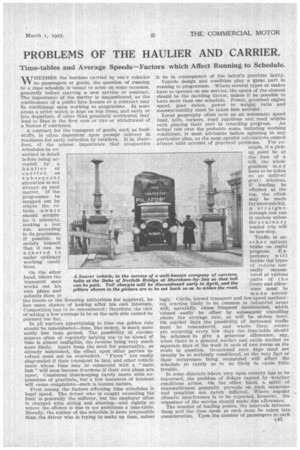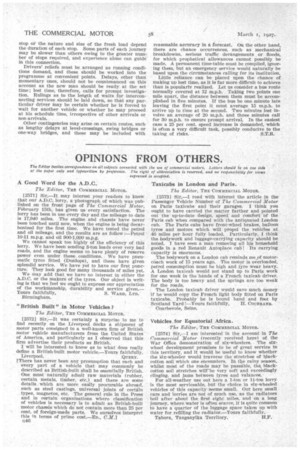PROBLEMS OF THE HAULIER AND CARRIER.
Page 67

Page 68

If you've noticed an error in this article please click here to report it so we can fix it.
Time-tables and Average Speeds—Factors which Affect Running to Schedule.
WHETHER the burdens carried by one's vehicles be passengers or goods, the question of running to a time schedule is bound to arise on some occasion, generally before starting a new service or contract. The importance of the matter is unquestioned, as the continuance of a public hire licence or a contract may be conditional upon working to programme. In some areas a strict watch is kept on bus times, and early or late departure, if other than genuinely accidental, may lead to fines in the first case or two or withdrawal of a licence if continued.
A contract for the transport of goods, such as foodstuffs, is often dependent upon prompt delivery in readiness for early collection by retailers. It is, therefore, of the utmost importance that prospective schedules he examined in detail before being accepted by a haulier or carrier, as subsequent alteration is not always an easy matter. if the programme be mapped out by others the vehicle owner should scrutinize it minutely, making a test run according to its provisions, if possible,. to satisfy himself that it can be adhered to under ordinary working conditions.
On the other hand, where the transport man works out his own plans and submits them to the hirers or the licensing authorities or approval, he has more chance of looking after his own interests. Competition has to be remembered ; therefore, the idea of setting a low average to be on the safe side cannot be pursued too far.
In all matters appertaining to time one golden rule should be remembered—time, like money, is much more easily lost than gained. The possibility of circumstances often or regularly helping one to be ahead of time is almost negligible, the reverse being very much more likely. Apart from the need for punctuality, as already mentioned, the effect upon other parties involved must not be overlooked. " Fares " are easily disgruntled if their transport be late, and other vehicle users whose runs may be connected with a "main link" will soon become fractious if their own plans are upset. Consistent time-keeping rarely meets with expressions of gratitude, but a few instances of lateness will cause complaints—such is human nature.
First among the factors affecting time schedules is legal speed. The driver who is caught exceeding the limit is generally the sufferer, but the employer often is charged with aiding and abetting—and rightly so where the offence is due to too ambitious a time-table. Morally, the author of the schedule is more responsible than the driver who is trying to make up time, unless it be in consequence of the latter's previous laxity. Vehicle design and condition play a great part in running to programme. Where several types or makes • have to operate on one service, the speed of the slowest should be the deciding factor, unless it be possible to have more than one schedule. Power, governed engine speed, gear ratios, power to weight ratio and manceuvrability must be taken into account.
Local geography often acts as an automatic speed limit, hills, corners, road junctions and road widths each playing their part in retarding progress. An actual test over the probable route, imitating working conditions, is most advisable before agreeing to any particular plan, as the most careful calculations cannot always take account of practical problems. For example, if a pickup point be at the foot of a hill, the whole gradient m a y have to be taken on an indirect gear ; whereas, if loading be effected at the top, the climb may be made far more quickly. A straightthrough test run is useless unless the ordinary loaded trip will be non-stop.
Traffic is another natural brake on ratild progress. E xperience will decide the types of vehicle nor mally encountered at various parts of t lie route and allowance must be made accord
ingly. Cattle, horsed transport and low-speed mechanical traction likely to be common in industrial areas will, naturally, cause • frequent deceleration, which 'caunot easily be offset by subsequent travelling .above the average., rate, as *will be shown later. On market days the possibility of increased traffic must be remembered, and where these events are occurring every few days the time-table should be schemed to give a generous allowance, say, when there is a general market and cattle market on separate days of the week in each of two towns on the route in question. Occasional race days need not usually be so seriously considered, as the very fact of their occurrence' being occasional will affect the schedule so rarely as to be likely to cause little trouble.
In some districts where very open country has to he traversed, . the problem . of delays caused by weather' conditions arises. On the other hand, a spirit of reasonableness generally prevails on. such occasions and penalties are. rarely inflicted. Where regular climatic interference is to be expected, however, the organizer of the service should make due. allowance.
The number of loading, points, the intervals between them and the time spent at each must be taken into. consideration. Upon the number of passengers to each
stop or the nature and size of the fresh load depend the duration of each stop. Some parts of each journey may be slower than others owing to the greater number of stops required, and experience alone can guide in this connection.
Drivers' reliefs must be arranged as running conditions demand, and these should be worked into the programme at convenient points. Delays, other than momentary ones, should not be countenanced on this account as the new man should be ready at the set time; lost time, therefore, calls for prompt investigation. Rulings as to the length of waits for interconnecting services should be laid down, so that any particular driver may be certain whether he is forced to wait for another vehicle or whether he may proceed at his schedule time, irrespective of other arrivals or non-arrivals.
Other contingencies may arise on certain routes, such as lengthy delays at level-crossings, swing bridges or one-way bridges, and these may be included with reasonable accuracy in a forecast. On the other hand, there are chance occurrences, such as mechanical breakdowns, serious traffic derangements or floods, for which prophetical allowances cannot possibly be made. A permanent time-table must be compiled, ignoring them, but an emergency service would naturally be based upon the circumstances calling for its institution.
Little reliance can be placed upon the chance of making up lost time, as it is far more difficult to achieve than is popularly realized. Let us consider a bus route normally covered at 12 m.p.h. Taking two points one mile apart, the distance between them must be accomplished in five minutes. If the bus be one minute late leaving the first point it must average 15 m.p.h. to arrive up to time at the second. Two minutes lost involve an average of 20 m.p.h. and three minutes call for 30 m.p.h. to ensure prompt arrival. In the easiest case a 25 per cent. speed increase is demanded, which is often a very difficult task, possibly conducive to the taking of risks. S.T.R.












































































































